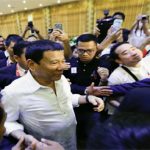The signed proclamation of state of national emergency “shall remain in force until lifted or withdrawn by the President,” said Communications Assistant Secretary Chris Ablan.
On Monday afternoon, September 5, before boarding the plane that would take him to the ASEAN meet in Laos, President Rodrigo Duterte signed the one-page proclamation. It was confirmed by Executive Secretary Salvador Medialdea on the same day.
Ablan explained that in a “state of national emergency on account of lawless violence,” the Armed Forces of the Philippines (AFP) and Philippine National Police (PNP) are commanded to “undertake measures permitted by the Constitution and laws to…suppress all forms of lawless violence in Mindanao.”
Moreover, the declaration also orders both AFP and PNP to “prevent lawless violence from spreading and escalating elsewhere with due regard to fundamental and civil political rights,” Ablan added.
This declaration of national emergency has no time limit. It is hinged on the president’s assessment of the peace and order situation in the country. If he sees that everything is in its proper place, then he may lift the declaration.
“The Constitution does not require a time limitation. This is not like martial law with a 60-day limitation,” Medialdea explained in mixed English and Filipino.
Some lawmakers fear that the declaration of a national emergency doubly empowering the military and police might be abused to trample on civil liberties. Another fear is that the declaration may go on indefinitely, which further makes it prone to misuse and exploitation.
But one thing for sure—there won’t be any curfew. Medialdea assured that the proclamation does not include curfews.
He explained that the proclamation and its signing were triggered by the recent incidents of terrorism in the country.
“’Yung mga nangyayari, ‘yung escape ng mga preso, mga grupo-grupo, then ‘yung mga beheadings and then eventually ‘yung nangyari sa Davao, ‘yun ‘yung naging basis (The things that are happening—the escape of prisoners, the different groups, then the beheadings, and then eventually the [bombing] incident in Davao—these became the basis [of the proclamation]),” the executive secretary explained in a phone interview.
Recently, imprisoned terrorists from the Maute group escaped from jail in Lanao del Sur. Also, the Abu Sayyaf terrorist group beheaded their foreign hostages and even a local boy whose family failed to give a ransom. Add to that the recent bombing of the Roxas night market in Davao City last week. All these led to the declaration of the “state of lawlessness.”
In another recent development, presidential legal council Chief Salvador Panelo disclosed that the draft of the “state of lawlessness” was actually being drafted even before the Davao blast happened.
Here’s the document, Proclamation No. 55, putting the Philippines under the state of national emergency:
— DZRH NEWS (@dzrhnews) September 6, 2016
1/2 READ: Malacañan, inilabas ang Proclamation No. 55 na nagde-deklara ng state of national emergency dahil sa… pic.twitter.com/S7qJJy26WG
Sources: (rappler.com, twitter.com)
[ads3]


